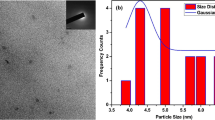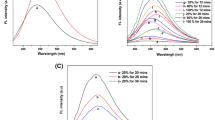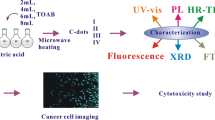Abstract
Carbon dots (CDs) are a new type of nanomaterial with great potential in bioimaging, biosensing, and drug delivery. In this study, novel CDs were prepared from cumin seeds (Cuminum cyminum L) by pyrolysis. The pyrolysis method and several extraction steps were optimized to fabricate CDs from cumin seed. The size, structure, chemical composition, and photoluminescence properties of the CDs were characterized using size analyzer, zeta sizer, TEM, SEM, EDX, UV-Vis, fluorescence spectroscopy, and FTIR. The influence of the CDs on cell viability was investigated in A549, 3T3, and MCF-7 cell lines using MTT assay. The cancer cell imaging potential of the CDs was assessed using fluorescence microscopy. The results showed that the CDs with a mean diameter of 13.4 ± 3.7 nm and zeta potential of -23.3 ± 7.5 mv can be obtained by the pyrolysis of cumin seed powder. The obtained CDs exhibited strong and unique fluorescence properties when they were excited at different wavelengths, particularly 350 nm. The CDs were highly stable over time, and their fluorescence properties remained unchanged after three months. Apart from the physicochemical properties of the CDs, cell viability assays showed that these CDs were non-toxic to A549, MCF-7, and 3T3 cells, over 90% of the cells were viable after 24 h, even at the highest concentration (1000 µg/ml). The CDs successfully penetrated the MCF-7 cells as revealed by fluorescent images. Taken together, the fluorescent CDs derived from cumin seeds through the presented facile technique indicated excellent and stable fluorescence properties. In addition, these CDs were highly biocompatible in vitro and could be a potential option for theragnostic applications.







Similar content being viewed by others
Data Availability
No datasets were generated or analysed during the current study.
References
M. Mohajeri, B. Behnam, A. Sahebkar, Biomedical applications of carbon nanomaterials: Drug and gene delivery potentials, Journal of Cellular Physiology, 234 (2019) 298-319.
M. Rezaee, B. Behnam, M. Banach, A. Sahebkar, The Yin and Yang of carbon nanomaterials in atherosclerosis, Biotechnology Advances, 36 (2018) 2232-2247.
M. Barani, M. Khatami, B. Behnam, R. Rajendram, P. Kesharwani, A. Sahebkar, 12 - Aptamer-conjugated carbon nanotubes or graphene for targeted cancer therapy and diagnosis, in: P. Kesharwani (Ed.) Aptamers Engineered Nanocarriers for Cancer Therapy, Woodhead Publishing, 2023, pp. 277-294.
S. Hassanpour, B. Behnam, B. Baradaran, M. Hashemzaei, F. Oroojalian, A. Mokhtarzadeh, M. de la Guardia, Carbon based nanomaterials for the detection of narrow therapeutic index pharmaceuticals, Talanta, 221 (2021) 121610.
M. Jorns, D. Pappas, A Review of Fluorescent Carbon Dots, Their Synthesis, Physical and Chemical Characteristics, and Applications, Nanomaterials (Basel), 11 (2021).
G.O. Adam, S.M. Sharker, J.H. Ryu, Emerging Biomedical Applications of Carbon Dot and Polymer Composite Materials, Applied Sciences, 12 (2022) 10565.
P. Zhao, Q. Zhang, J. Cao, C. Qian, J. Ye, S. Xu, Y. Zhang, Y. Li, Facile and Green Synthesis of Highly Fluorescent Carbon Quantum Dots from Water Hyacinth for the Detection of Ferric Iron and Cellular Imaging, Nanomaterials, 12 (2022) 1528.
J. Pardo, Z. Peng, R.M. Leblanc, Cancer targeting and drug delivery using carbon-based quantum dots and nanotubes, Molecules, 23 (2018) 378.
Y. Bai, Y. Wang, L. Cao, Y. Jiang, Y. Li, H. Zou, L. Zhan, C. Huang, Self-Targeting Carbon Quantum Dots for Peroxynitrite Detection and Imaging in Live Cells, Analytical Chemistry, 93 (2021) 16466-16473.
X. He, Q. Luo, J. Zhang, P. Chen, H.-J. Wang, K. Luo, X.-Q. Yu, Gadolinium-doped carbon dots as nano-theranostic agents for MR/FL diagnosis and gene delivery, Nanoscale, 11 (2019) 12973-12982.
A. Qureashi, A.H. Pandith, A. Bashir, L.A. Malik, Biomass-derived carbon quantum dots: a novel and sustainable fluorescent “ON–OFF–ON” sensor for ferric ions, Analytical Methods, 13 (2021) 4756-4766.
Z. Wang, F. Cheng, H. Cai, X. Li, J. Sun, Y. Wu, N. Wang, Y. Zhu, Robust versatile nanocellulose/polyvinyl alcohol/carbon dot hydrogels for biomechanical sensing, Carbohydrate Polymers, 259 (2021) 117753.
R.R. Zairov, A.P. Dovzhenko, K.A. Sarkanich, I.R. Nizameev, A.V. Luzhetskiy, S.N. Sudakova, S.N. Podyachev, V.A. Burilov, I.M. Vatsouro, A. Vomiero, Single excited dual band luminescent hybrid carbon dots-terbium chelate nanothermometer, Nanomaterials, 11 (2021) 3080.
M. Zulfajri, H.N. Abdelhamid, S. Sudewi, S. Dayalan, A. Rasool, A. Habib, G.G. Huang, Plant Part-Derived Carbon Dots for Biosensing, Biosensors, 10 (2020) 68.
V. Rimal, S. Shishodia, P.K. Srivastava, S. Gupta, A.I. Mallick, Synthesis and characterization of Indian essential oil Carbon Dots for interdisciplinary applications, Applied Nanoscience, 11 (2021) 1225-1239.
A. Sharma, J. Das, Small molecules derived carbon dots: synthesis and applications in sensing, catalysis, imaging, and biomedicine, Journal of Nanobiotechnology, 17 (2019) 92.
P.T. Anastas, E.S. Beach, Green chemistry: the emergence of a transformative framework, Green Chemistry Letters and Reviews, 1 (2007) 9-24.
W. Meng, X. Bai, B. Wang, Z. Liu, S. Lu, B. Yang, Biomass-Derived Carbon Dots and Their Applications, ENERGY & ENVIRONMENTAL MATERIALS, 2 (2019) 172-192.
V. Sharma, P. Tiwari, S.M. Mobin, Sustainable carbon-dots: recent advances in green carbon dots for sensing and bioimaging, Journal of Materials Chemistry B, 5 (2017) 8904-8924.
O.V. Kharissova, B.I. Kharisov, C.M. Oliva González, Y.P. Méndez, I. López, Greener synthesis of chemical compounds and materials, Royal Society open science, 6 (2019) 191378.
M. Zulfajri, G. Gedda, C.-J. Chang, Y.-P. Chang, G.G. Huang, Cranberry Beans Derived Carbon Dots as a Potential Fluorescence Sensor for Selective Detection of Fe3+ Ions in Aqueous Solution, ACS Omega, 4 (2019) 15382-15392.
A. Dager, T. Uchida, T. Maekawa, M. Tachibana, Synthesis and characterization of Mono-disperse Carbon Quantum Dots from Fennel Seeds: Photoluminescence analysis using Machine Learning, Scientific Reports, 9 (2019) 14004.
J. Mejía Ávila, M. Rangel Ayala, Y. Kumar, E. Pérez-Tijerina, M.A.R. Robles, V. Agarwal, Avocado seeds derived carbon dots for highly sensitive Cu (II)/Cr (VI) detection and copper (II) removal via flocculation, Chemical Engineering Journal, 446 (2022) 137171.
M. Zulfajri, S. Dayalan, W.-Y. Li, C.-J. Chang, Y.-P. Chang, G.G. Huang, Nitrogen-Doped Carbon Dots from Averrhoa carambola Fruit Extract as a Fluorescent Probe for Methyl Orange, Sensors, 19 (2019) 5008.
A.E. Al-Snafi, The pharmacological activities of Cuminum cyminum-A review, IOSR Journal of Pharmacy, 6 (2016) 46-65.
R. Mohammadinejad, A. Dehshahri, H.A. Sassan, B. Behnam, M. Ashrafizadeh, A. Samareh Gholami, A. Pardakhty, A. Mandegary, Preparation of carbon dot as a potential CRISPR/Cas9 plasmid delivery system for lung cancer cells, Minerva Biotecnologica, (2020).
B. Behnam, M. Rezazadehkermani, S. Ahmadzadeh, A. Mokhtarzadeh, S.N. Nematollahi-Mahani, A. Pardakhty, Microniosomes for concurrent doxorubicin and iron oxide nanoparticles loading; preparation, characterization and cytotoxicity studies, Artif Cells Nanomed Biotechnol, 46 (2018) 118-125.
M. Mazarei, P. Mohammadi Arvejeh, M.R. Mozafari, P. Khosravian, S. Ghasemi, Anticancer Potential of Temozolomide-Loaded Eudragit-Chitosan Coated Selenium Nanoparticles: In Vitro Evaluation of Cytotoxicity, Apoptosis and Gene Regulation, Nanomaterials (Basel), 11 (2021).
A. Mewada, S. Pandey, S. Shinde, N. Mishra, G. Oza, M. Thakur, M. Sharon, M. Sharon, Green synthesis of biocompatible carbon dots using aqueous extract of Trapa bispinosa peel, Mater Sci Eng C Mater Biol Appl, 33 (2013) 2914-2917.
J.-H. Zhang, A. Niu, J. Li, J.-W. Fu, Q. Xu, D.-S. Pei, In vivo characterization of hair and skin derived carbon quantum dots with high quantum yield as long-term bioprobes in zebrafish, Scientific Reports, 6 (2016) 37860.
P. Zhao, L. Zhu, Dispersibility of carbon dots in aqueous and/or organic solvents, Chemical Communications, 54 (2018) 5401-5406.
G. Gedda, C.-Y. Lee, Y.-C. Lin, H.-f. Wu, Green synthesis of carbon dots from prawn shells for highly selective and sensitive detection of copper ions, Sensors and Actuators B: Chemical, 224 (2016) 396-403.
S. Chahal, J.-R. Macairan, N. Yousefi, N. Tufenkji, R. Naccache, Green synthesis of carbon dots and their applications, RSC Advances, 11 (2021) 25354-25363.
R. V, V. Gujar, H. Pathan, S. Islam, M. Tawre, K. Pardesi, M.K. Santra, D. Ottoor, Bioimaging Applications of Carbon dots (C. dots) and its Cystamine Functionalization for the Sensitive Detection of Cr(VI) in Aqueous Samples, J Fluoresc, 29 (2019) 1381-1392.
X. Wang, Y. Zhang, M. Zhang, H. Kong, S. Wang, J. Cheng, H. Qu, Y. Zhao, Novel carbon dots derived from puerariae lobatae radix and their anti-gout effects, Molecules, 24 (2019) 4152.
X. Yan, Y. Zhao, J. Luo, W. Xiong, X. Liu, J. Cheng, Y. Wang, M. Zhang, H. Qu, Hemostatic bioactivity of novel Pollen Typhae Carbonisata-derived carbon quantum dots, Journal of Nanobiotechnology, 15 (2017) 60.
M. Zhang, Y. Zhao, J. Cheng, X. Liu, Y. Wang, X. Yan, Y. Zhang, F. Lu, Q. Wang, H. Qu, Novel carbon dots derived from Schizonepetae Herba Carbonisata and investigation of their haemostatic efficacy, Artificial Cells, Nanomedicine, and Biotechnology, 46 (2018) 1562-1571.
X. Yan, Y. Zhao, J. Luo, W. Xiong, X. Liu, J. Cheng, Y. Wang, M. Zhang, H. Qu, Hemostatic bioactivity of novel Pollen Typhae Carbonisata-derived carbon quantum dots, Journal of Nanobiotechnology, 15 (2017) 1-8.
F. Wang, Y.-h. Chen, C.-y. Liu, D.-g. Ma, White light-emitting devices based on carbon dots’ electroluminescence, Chemical Communications, 47 (2011) 3502-3504.
Y. Wu, C. Li, H.C. van der Mei, H.J. Busscher, Y. Ren, Carbon quantum dots derived from different carbon sources for antibacterial applications, Antibiotics, 10 (2021) 623.
M. He, J. Zhang, H. Wang, Y. Kong, Y. Xiao, W. Xu, Material and optical properties of fluorescent carbon quantum dots fabricated from lemon juice via hydrothermal reaction, Nanoscale Research Letters, 13 (2018) 1-7.
L. Xiao, H. Sun, Novel properties and applications of carbon nanodots, Nanoscale Horizons, 3 (2018) 565-597.
A. Tomczyk, Z. Sokołowska, P. Boguta, Biochar physicochemical properties: pyrolysis temperature and feedstock kind effects, Reviews in Environmental Science and Bio/Technology, 19 (2020) 191-215.
C. Dias, N. Vasimalai, P.S. M, I. Pinheiro, V. Vilas-Boas, J. Peixoto, B. Espiña, Biocompatibility and Bioimaging Potential of Fruit-Based Carbon Dots, Nanomaterials (Basel), 9 (2019).
W. Shi, Q. Han, J. Wu, C. Ji, Y. Zhou, S. Li, L. Gao, R.M. Leblanc, Z. Peng, Synthesis Mechanisms, Structural Models, and Photothermal Therapy Applications of Top-Down Carbon Dots from Carbon Powder, Graphite, Graphene, and Carbon Nanotubes, International Journal of Molecular Sciences, 23 (2022) 1456.
H. Shabbir, K. Wojtaszek, B. Rutkowski, E. Csapó, M. Bednarski, A. Adamiec, M. Głuch-Lutwin, B. Mordyl, J. Druciarek, M. Kotańska, P. Ozga, M. Wojnicki, Milk-Derived Carbon Quantum Dots: Study of Biological and Chemical Properties Provides Evidence of Toxicity, Molecules, 27 (2022) 8728.
Acknowledgements
This work was financially supported by the Kerman University of Medical Sciences, Kerman, Iran (Grant No. 98001106). This research paper is the report of Fatemeh Askarian’s Pharm D thesis.
Author information
Authors and Affiliations
Contributions
B.B: Study design and supervision, analyzing the results, investigation, and critical review of the project. B.A: Analyzing the results, drafting, and editing the manuscript. F.A: Performing experimental sections, data acquisition, and analyzing the results. N.M: Drafting the manuscript.
Corresponding author
Ethics declarations
Competing Interests
The authors declare no competing interests.
Ethical Approval
This study was conducted in accordance with ethical guidelines, and the approval code assigned to the study was IR.KMU.REC.1399.066.
Additional information
Publisher's Note
Springer Nature remains neutral with regard to jurisdictional claims in published maps and institutional affiliations.
Rights and permissions
Springer Nature or its licensor (e.g. a society or other partner) holds exclusive rights to this article under a publishing agreement with the author(s) or other rightsholder(s); author self-archiving of the accepted manuscript version of this article is solely governed by the terms of such publishing agreement and applicable law.
About this article
Cite this article
Abadi, B., Askarian, F., Mohamadi, N. et al. Fluorescent Carbon Dots from Cumin Seeds: Preparation, Characterization and In Vitro Biocompatibility Test for Cell Imaging Application. J Clust Sci (2024). https://doi.org/10.1007/s10876-024-02609-w
Received:
Accepted:
Published:
DOI: https://doi.org/10.1007/s10876-024-02609-w




